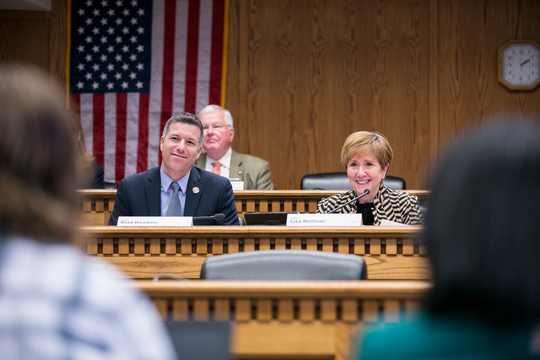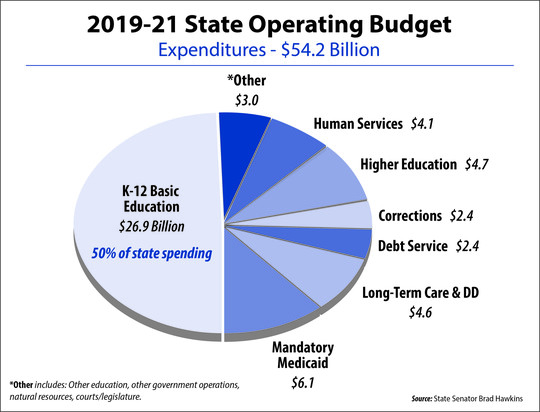February 9, 2021
Dear Friends and Neighbors,
The Washington State Constitution describes education as its “paramount duty,” and the Legislature dedicates half of its $54 billion operating budget to K-12 education. Each year, lawmakers fiercely debate educational reform topics from school funding, graduation standards, and collective bargaining to levy reform, curriculum choices, and testing requirements. More recently, as a result of the COVID pandemic, school districts are focused on remote learning, technology needs, and safe reopening.
Does current “school year” model make sense?
One of the things missing from the overall discussion, in my opinion, is whether the current school year model makes sense for a 21st century school. Why is it that Washington taxpayers and people across America invest so much into their school systems while annually accepting an antiquated school calendar? Is it the most prudent use of taxpayer funds from a return on investment perspective to resign ourselves to a schedule year after year that leaves students across our state with three months of no instruction and a month of reteaching every September? If we could redesign the school calendar today, wouldn’t we do things very differently?
 As the ranking Republican member on the Senate’s Early Learning and K-12 Education Committee, I work closely with Chair Lisa Wellman of the 41st District on education issues. She is a co-sponsor of my Senate Bill 5147 to address student “learning loss” by exploring voluntary adjustments to alternative school calendars.
My bipartisan Senate Bill 5147 to provide school districts more options is gaining support
These are the questions I am attempting to answer in my Senate Bill 5147, a bill co-sponsored by many legislators, including committee chairs and leadership members from both parties. The bill includes a financial incentive for any district that chooses to voluntarily apportion their existing 180 state-funded school days over a full year. This will likely require multiple three-week breaks throughout the year or a few one-month breaks. The bill was recently approved by the Senate’s Early Learning and K-12 Education Committee. The bill has another hearing this afternoon before the Senate’s Ways and Means Committee, which develops the Senate’s budget proposal. Many stakeholders are expected to testify, including local educational leaders Michelle Price, superintendent of the North Central Educational Service District, Gene Sharratt former superintendent and Washington State cabinet member, and Tom Venable, superintendent of the Methow Valley School District. Both the Early Learning and K-12 Education Committee and Ways and Means Committee are working to address “learning loss” this legislative session. Learning loss is something that will, unfortunately, impact nearly every student across Washington state due to the COVID pandemic and the less-than-ideal circumstances associated with statewide remote learning. Some students could spend most of their remaining K-12 years just trying to catch up to their pre-pandemic academic learning trajectory. Sadly, many students will be burdened by COVID’s educational impacts for many years to come.
 The Washington Legislature dedicates half of its $54 billion operating budget to K-12 education. With so many taxpayer dollars ($26.9 billion) provided to education and the recent COVID educational impacts, now seems like the right time for schools to explore a more balanced school calendar.
“Learning Loss” occurs annually but especially this year due to the COVID pandemic
The COVID educational impacts will burden most students for many years and likely will be compounded by the continual learning loss in future years, which occurs every summer as a result of outdated school calendars historically designed to accommodate our agricultural needs. Our current school calendar was created to allow students to have a three-month summer break to assist their families on their farms but became commonly accepted over time and now goes largely unquestioned. It’s now time to think about transformational changes that could help every student across Washington. With my bipartisan effort outlined in Senate Bill 5147, I’m calling on my colleagues in the Legislature to think differently about how to improve our educational delivery system. If we cannot do it now, as we prepare to pull ourselves out of this pandemic, when will we ever be able to? Fortunately, my legislative colleagues and I are not alone. Our Superintendent of Public Instruction Chris Reykdal identifies “balancing the school calendar” as one of his “10 strategic changes” for our schools, and I agree. In a January 8 letter to the governor and legislators, Superintendent Reykdal urged us to explore options to help our schools “become the highest performing public education system in the nation.”
I do not think we get there by taking a long break every summer. I shared a similar opinion in my guest editorial in The Seattle Times published February 3 and during an interview on KONA Radio on February 2.
Additional links to recent media
Here are more links to recent media coverage, including articles, interviews, and hearings:
Thank you for the opportunity to serve as your state senator.
Sincerely,

Brad Hawkins
State Senator
Brad Hawkins
12th Legislative District
E-mail:
brad.hawkins@leg.wa.gov
Website: senatorbradhawkins.org
107 Newhouse Building
- P.O. Box 40412 | Olympia, WA 98504-0412
(360) 786-7622 or Toll-free: (800) 562-6000
|